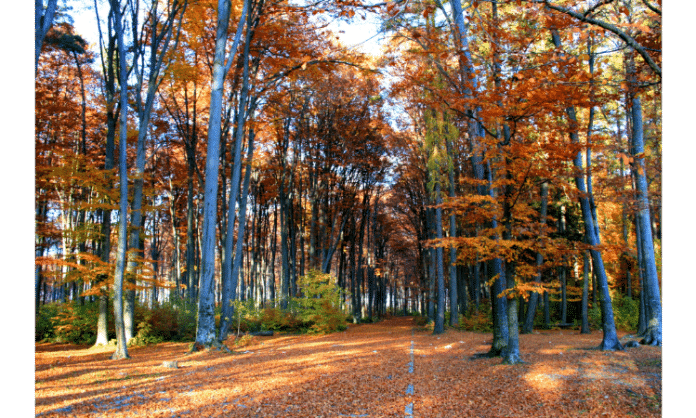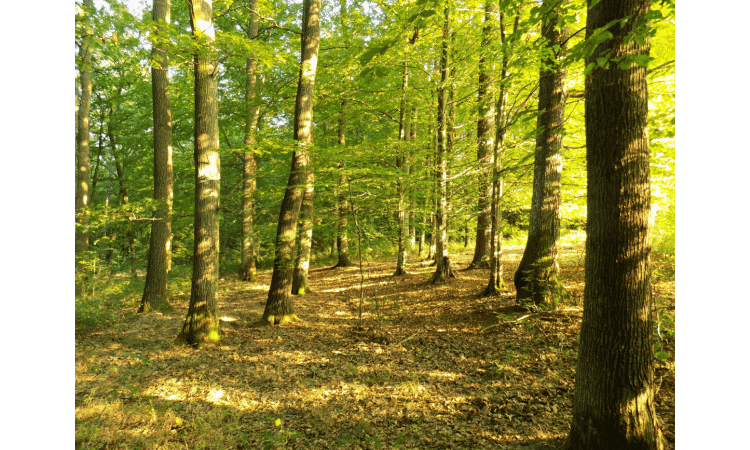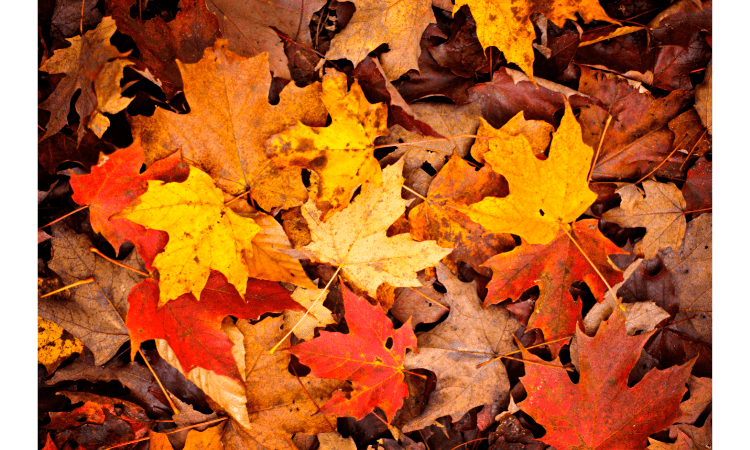
I. Introduction
A. Brief overview of deciduous forests:
Deciduous forests are a type of biome characterized by the presence of trees that shed their leaves seasonally, typically during autumn. These forests are primarily found in temperate regions, with notable examples being the Eastern United States, Europe, and parts of Asia. Deciduous forests experience four distinct seasons of diversity – spring, summer, autumn, and winter – with varying temperature and precipitation patterns.

Deciduous forests are home to a diverse range of plant and animal species. The tree species commonly found in these forests include oak, maple, beech, and elm, among others. The forest floor is covered with a layer of leaf litter, which decomposes and provides nutrients to the soil, contributing to the overall fertility and richness of the ecosystem.
Animals that inhabit deciduous forests are adapted to the changing seasons and include mammals such as deer, squirrels, and foxes, as well as various bird species like woodpeckers and owls. The forests provide shelter and food resources for these animals, allowing them to thrive in this environment.
The unique characteristics of deciduous forests in different seasons make them important ecosystems in terms of biodiversity, carbon sequestration, and recreation. They also play a crucial role in maintaining the global climate by storing and releasing carbon dioxide through the process of photosynthesis and respiration. Additionally, these forests provide essential resources such as timber and non-timber forest products, which support local and global economies.
B. Importance of understanding the seasonal changes:
Each season in deciduous forests comes with its own set of characteristics, offering a dynamic and ever-changing environment that influences the behavior, growth, and survival of the resident species. Understanding these seasonal changes helps us appreciate the delicate balance within these ecosystems and underscores the importance of conserving these valuable natural habitats.
C. Preview of the blog’s content:
In this blog, we will embark on a journey through the beauty and diversity of deciduous forests, exploring each season’s unique features, and uncovering the fascinating adaptations of the flora and fauna that call these forests home. We will also discuss the ecological importance of deciduous forests and the ongoing conservation efforts to ensure their preservation for future generations.
II. The beauty of spring in deciduous forests
A. New growth and budding leaves:

Spring marks the beginning of new life in deciduous forests, as trees start to produce new leaves and growth after a period of dormancy during winter. The warmer temperatures and increased daylight hours trigger the process of photosynthesis, allowing the trees to produce energy and support new growth. The forest canopy starts to fill with fresh, green leaves, creating a vibrant and lively atmosphere.
B. Flowering plants and trees:
As temperatures rise, a variety of plants and trees begin to flower, adding splashes of color to the forest landscape. The blossoms not only provide a visual treat but also play a crucial role in the reproductive cycle of plants by attracting pollinators such as bees, butterflies, and hummingbirds. The pollinators aid in transferring pollen between flowers, ensuring the continuation of the plant species.
C. Migratory birds returning to nest:

Springtime in deciduous forests is marked by the return of migratory bird species that had flown to warmer regions during winter. These birds come back to their breeding grounds to mate and build nests, filling the forests with their melodic songs and vibrant plumage. This influx of avian life adds to the overall diversity and activity within the forest ecosystem.
D. Wildlife awakening from hibernation:
As the weather warms up and food resources become more abundant, animals that had been hibernating or in a state of torpor during winter start to emerge. Mammals such as bears, hedgehogs, and ground squirrels awaken from their long slumber, while insects and amphibians also become active. The increase in animal activity contributes to the sense of rejuvenation and vitality that is characteristic of spring in deciduous forests.
III. The lushness of summer in deciduous forests
A. Dense foliage and vibrant greenery:
As summer arrives, deciduous forests are at their peak in terms of foliage density and lush greenery. The trees are adorned with mature leaves, creating a thick canopy that filters sunlight and casts dappled shade on the forest floor. The abundance of greenery provides a picturesque setting for outdoor enthusiasts and nature lovers.
B. Abundant food resources for animals:
The warm summer months bring an abundance of food resources for the forest’s inhabitants. Fruits, nuts, and seeds ripen on trees and plants, providing nourishment for a wide range of animals, including birds, squirrels, and deer. Insect populations also flourish during this time, supplying food for insectivores like birds, bats, and amphibians.
C. Insects and pollinators thriving:
Summer is a bustling time for insects and other pollinators in deciduous forests. Bees, butterflies, and other insects feed on the nectar and pollen of flowering plants, while simultaneously helping with pollination. This mutualistic relationship between plants and their pollinators contributes to the overall health and diversity of the forest ecosystem.
D. Ideal conditions for outdoor exploration:
The warm weather, extended daylight hours, and vibrant landscapes make summer an ideal time to explore deciduous forests. Hiking, birdwatching, and nature photography are popular activities during this season, allowing visitors to immerse themselves in the beauty and diversity of these ecosystems. Spending time in deciduous forests during summer also provides an opportunity to learn about the various plant and animal species that thrive in this environment.
IV. The colorful palette of autumn in deciduous forests
A. The process of leaf senescence and changing colors:
Autumn in deciduous forests is marked by a stunning display of colors as leaves change from shades of green to vibrant hues of yellow, orange, and red. This transformation is a result of the process of leaf senescence, during which chlorophyll, the pigment responsible for the green color in leaves, breaks down. As chlorophyll diminishes, other pigments like carotenoids and anthocyanins become more visible, giving the leaves their characteristic fall colors.
B. Falling leaves and their ecological significance:

As the season progresses, deciduous trees shed their leaves, creating a blanket of leaf litter on the forest floor. This leaf litter plays a crucial role in the forest ecosystem, as it decomposes and releases nutrients back into the soil, contributing to overall soil fertility. Additionally, the fallen leaves provide shelter and habitat for various insects, fungi, and other small organisms, supporting biodiversity within the forest.
C. Animal adaptations for food storage and preparation for winter:
As autumn approaches, animals in deciduous forests prepare for the upcoming winter months. Many species, such as squirrels and chipmunks, store food resources like nuts and seeds in caches to ensure they have enough sustenance during the colder months. Birds and other migratory animals start their journey to warmer climates, while other species, like bears, begin to build up fat reserves in preparation for hibernation.
D. Seasonal activities and scenic photography opportunities:
The vibrant colors and crisp air of autumn create an ideal setting for outdoor activities and nature photography in deciduous forests. Visitors can enjoy hiking, wildlife observation, and capturing breathtaking scenery during this magical season. The picturesque landscapes also provide inspiration for artists and writers, drawing them to these forests to experience the beauty and serenity of autumn.
V. The quiet serenity of winter in deciduous forests
A. Trees and plants in dormancy:
Winter brings cold temperatures and shorter days to deciduous forests, causing trees and plants to enter a period of dormancy. The once-lush canopy is now bare, with trees having shed their leaves in autumn. This leafless state helps the trees conserve water and energy during the harsh winter months, allowing them to survive until the warmer temperatures of spring return.
B. Snow-covered landscapes and frozen water sources:
Snowfall often blankets the deciduous forest landscape, creating a serene and picturesque scene. The layer of snow insulates the soil, protecting plant roots and small organisms from extreme cold. Water sources, such as ponds and streams, may freeze over, altering the availability of water for the forest’s inhabitants.
C. Adaptations of animals that remain active during winter:
While some animals in deciduous forests hibernate or migrate to warmer climates during winter, others have adapted to remain active. These animals, such as deer, foxes, and some bird species, rely on their resourcefulness and physical adaptations to survive the cold and find food. They may grow thicker fur or feathers, change their feeding habits, or alter their behavior to conserve energy.
D. The role of winter in the overall forest life cycle:
Although winter may seem like a dormant and quiet time in deciduous forests, it plays a crucial role in the life cycle of the forest ecosystem. The period of dormancy allows trees and plants to conserve resources and prepare for the growth and reproduction that will occur in the following spring. Additionally, the winter season serves as a time of renewal and regeneration, as the accumulated snow and ice melt, replenishing the soil and water sources when warmer temperatures arrive.
VI. The ecological importance of deciduous forests
A. Biodiversity and habitat provision:

Deciduous forests are vital ecosystems that support a rich diversity of plant and animal life. The complex interplay of biotic and abiotic factors within these forests creates a variety of habitats and niches for countless species. From the towering trees to the leaf-littered forest floor, these habitats cater to the needs of different organisms and contribute to the overall health of the ecosystem.
B. Carbon sequestration and climate regulation:
Deciduous forests play a critical role in mitigating climate change by sequestering carbon dioxide from the atmosphere through the process of photosynthesis. Trees and other plants absorb and store carbon in their tissues, effectively reducing greenhouse gas concentrations in the atmosphere. Moreover, these forests also help regulate local and regional climates by influencing temperature, humidity, and precipitation patterns.
C. Ecosystem services and human reliance on forest resources:
Deciduous forests provide numerous ecosystem services that are essential for human well-being. These services include the provision of timber and non-timber forest products, water regulation and purification, soil formation, and recreational opportunities. Additionally, these forests have cultural and spiritual significance for many communities, as they have been a source of inspiration, knowledge, and tradition throughout human history.
VII. Conservation efforts and sustainable practices
A. Challenges facing deciduous forests:

Deciduous forests face various threats due to human activities, including deforestation, urbanization, and climate change. These factors contribute to habitat loss, fragmentation, and a decline in biodiversity. The increasing pressure on these ecosystems highlights the urgent need for their conservation and sustainable management.
B. The role of sustainable forest management:
Implementing sustainable forest management practices is crucial for maintaining the ecological integrity and resilience of deciduous forests. These practices aim to balance the need for resource extraction with the long-term health and functioning of the ecosystem. Measures such as selective logging, habitat restoration, and preserving old-growth forests can help ensure the conservation of these valuable natural environments.
C. Reforestation and habitat restoration efforts:
Reforestation and habitat restoration initiatives play an essential role in the conservation of deciduous forests. These efforts involve replanting native tree species, restoring damaged ecosystems, and creating wildlife corridors to connect fragmented habitats. By increasing forest cover and improving habitat quality, reforestation, and restoration projects can help safeguard the future of deciduous forests and the diverse species that depend on them.
D. How individuals can contribute to forest conservation:
There are several ways that individuals can support the conservation of deciduous forests:
- Education and awareness: Learn about the importance of deciduous forests, the threats they face, and the conservation efforts in place to protect them. Share this knowledge with others to raise awareness and foster an appreciation for these ecosystems.
- Responsible tourism: When visiting deciduous forests, practice responsible tourism by staying on designated trails, minimizing waste, and avoiding any activities that could harm the environment or its inhabitants.
- Supporting conservation organizations: Donate to or volunteer with organizations dedicated to conserving deciduous forests and their biodiversity. These organizations often rely on public support to fund their initiatives and raise awareness.
- Sustainable consumption: Choose products made from sustainably sourced materials and certified by reputable organizations, such as the Forest Stewardship Council (FSC). By doing so, you support companies that prioritize sustainable forestry practices.
- Engaging in local efforts: Participate in tree planting, habitat restoration, or community conservation projects in your local area. These activities not only contribute to the health of deciduous forests but also foster a sense of stewardship and connection to the natural world.
VIII. Conclusion
A. Recap of the journey through the seasons in deciduous forests:
Throughout this blog, we have explored the unique features and adaptations of deciduous forests across the four distinct seasons. From the vibrant growth of spring to the serene stillness of winter, each season offers a glimpse into the intricate workings of these ecosystems and the diverse species that inhabit them.
B. Emphasizing the beauty, diversity, and importance of these ecosystems:

Deciduous forests are essential ecosystems that support an incredible array of plant and animal life. Their beauty, diversity, and ecological significance cannot be overstated, and their conservation is crucial for maintaining the balance of our planet’s natural systems.
C. Encouraging readers to explore and appreciate deciduous forests:
We hope this journey has inspired you to further explore and appreciate deciduous forests, whether through personal visits, learning more about their ecology, or supporting conservation initiatives. By fostering a deeper connection with these ecosystems, we can all contribute to their preservation and ensure their continued existence for generations to come.











